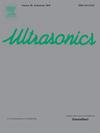Geometric a priori informed bent-ray tracing for accelerated sound speed imaging in ultrasound computed tomography
IF 3.8
2区 物理与天体物理
Q1 ACOUSTICS
引用次数: 0
Abstract
Bent-ray tracing ultrasound computed tomography (USCT) is a promising technique for breast cancer screening which quantitatively provides speed-of-sound (SOS) distribution in human breasts. In this modality, SOS images are reconstructed with an iterative process to match the measured time-of-flights and the ones predicted by Eikonal equation solved with the fast marching method (FMM). The Eikonal equation is meant to be applied in SOS heterogeneous media and its evaluation with FMM is an computational expensive process. However, in USCT, the object is placed in a homogeneous coupling medium. Thus, the acoustic environment is formed by two parts, the homogeneous background (coupling medium) and the heterogeneous object. In this work, we leverage this strong a priori information and propose a method to accelerate SOS image formation for bent-ray tracing USCT. We show that, given the boundary information of the object, Eikonal equation only needs to be evaluated in a limited area covering the object. For that, the partial FMM and the associated ray-tracing strategy are proposed to reduce the computational cost of the forward modeling. We also managed to restrict image reconstruction area inside the object for improved convergence rate of the optimization. Both the simulation and phantom imaging experiments with ring transducer arrays demonstrated that the proposed method reduces the reconstruction time in an object size dependent manner. For the object occupying 20.3% to 56.3% of the image field of the ring array, we observed 30.1%–61.9% reduction in image reconstruction time without sacrificing the image quality, compared to classical method. The proposed strategy can be adopted for fast SOS imaging with bent-ray tracing USCT to improve patient throughput for breast cancer screening.
求助全文
约1分钟内获得全文
求助全文
来源期刊

Ultrasonics
医学-核医学
CiteScore
7.60
自引率
19.00%
发文量
186
审稿时长
3.9 months
期刊介绍:
Ultrasonics is the only internationally established journal which covers the entire field of ultrasound research and technology and all its many applications. Ultrasonics contains a variety of sections to keep readers fully informed and up-to-date on the whole spectrum of research and development throughout the world. Ultrasonics publishes papers of exceptional quality and of relevance to both academia and industry. Manuscripts in which ultrasonics is a central issue and not simply an incidental tool or minor issue, are welcomed.
As well as top quality original research papers and review articles by world renowned experts, Ultrasonics also regularly features short communications, a calendar of forthcoming events and special issues dedicated to topical subjects.
 求助内容:
求助内容: 应助结果提醒方式:
应助结果提醒方式:


